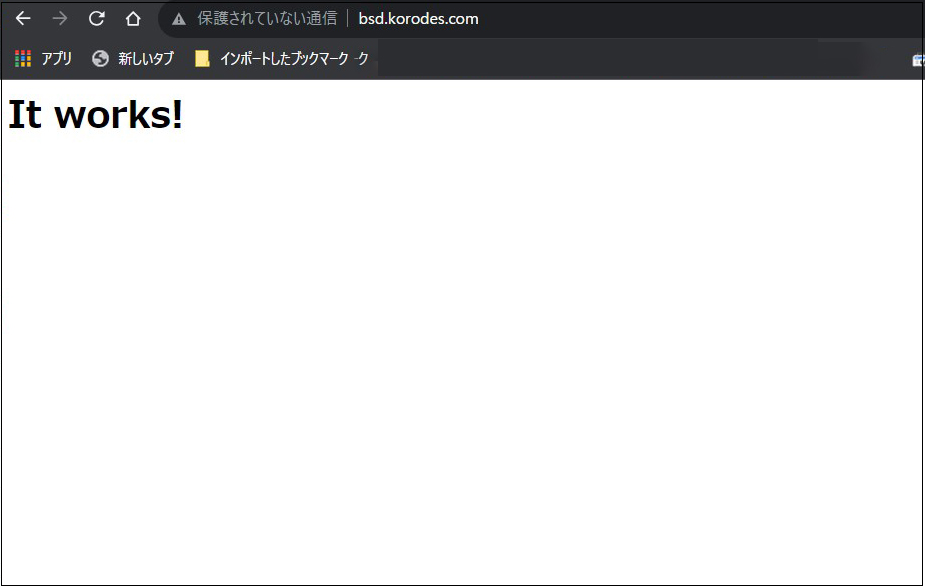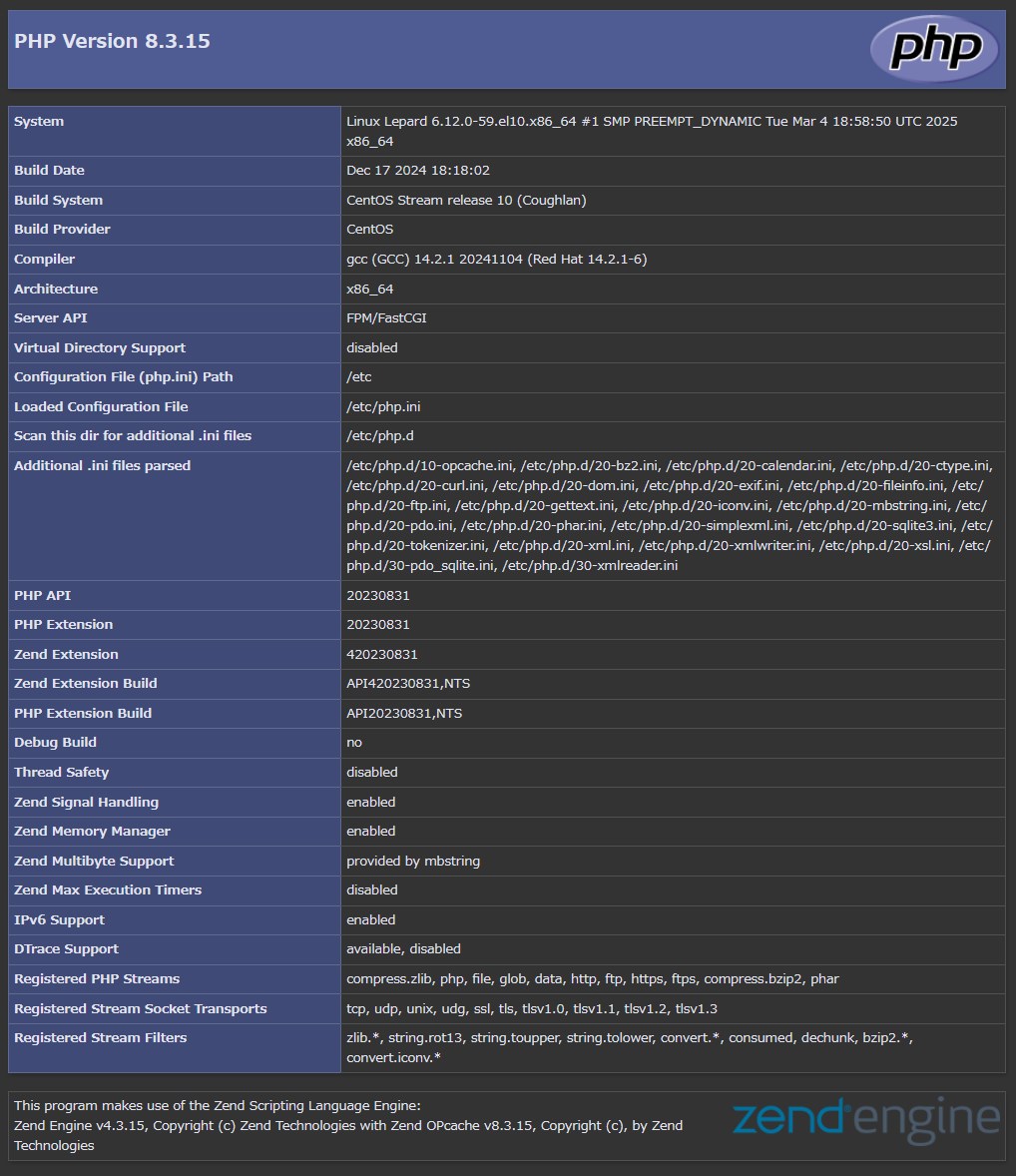Contents
1. Apache2
1.1 Install
|
1 |
# pkg install -y apache24 |
|
1 2 3 |
# httpd -v Server version: Apache/2.4.62 (FreeBSD) Server built: unknown |
|
1 2 3 4 5 6 |
# service apache24 enable # service apache24 start # service apache24 status apache24 is running as pid 1159 |
1.2 apache24 - setting
①extra/httpd-default.conf editing
|
1 2 3 4 5 6 |
# vi /usr/local/etc/apache24/extra/httpd-default.conf For security purposes, change the settings as follows 55行目 ServerTokens ProductOnly The default setting is “Full”, but change it to “ProductOnly”. |
➁httpd.conf editing
|
1 2 3 4 5 6 7 8 9 10 11 12 13 14 15 16 17 18 19 20 21 |
# vi /usr/local/etc/apache24/httpd.conf Line 160 : Uncomment LoadModule dav_module libexec/apache24/mod_dav.so Line 217 : Change to administrator's email address ServerAdmin you@example.com Line 226 : Definition of the server's domain name and listening port number. #ServerName www.example.com:80 ServerName [domain]:80 Line 264 : Indexes delete Options FollowSymLinks Line 271 : change AllowOverride ALL To enable the setting to "/usr/local/etc/apache24/extra/httpd-default.conf" configured in the previous section, delete "#" at the beginning of the following and enable "Include". Line 518 : Uncomment Include etc/apache24/extra/httpd-default.conf |
If you access the server (http://server-IP [or domain name]) from the client, you should see something like the following

1.3 Virtual Host Settings
document root: /usr/local/www/apache24/data/[FQDN]/
dpmain : [FQDN]
Set up virtual hosts
|
1 2 3 |
# vi /usr/local/etc/apache24/httpd.conf Fill in the following at the end Include etc/apache24/extra/bsd-vhost.conf |
Create new bsd-vhost.conf under /usr/local/etc/apache24/extra(bsd-vhost in bsd-vhost.conf is an arbitrary name)
|
1 2 3 4 5 6 7 8 9 10 11 12 13 14 15 16 |
# cd /usr/local/etc/apache24/extra # vi bsd-vhost.conf Created with the following content <VirtualHost *:80> ServerAdmin Administrator's email address DocumentRoot "/usr/local/www/apache24/data/[FQDN]" ServerName [FQDN] ErrorLog "/var/log/[FQDN].com-error_log" CustomLog "/var/log/[FQDN].access_log" common </VirtualHost> <Directory /usr/local/www/apache24/data/[FQDN]> AddHandler cgi-script .cgi Options FollowSymlinks Includes AllowOverride All Require all granted </Directory> |
directory creation
|
1 2 3 |
# mkdir /usr/local/www/apache24/data/[FQDN] # chown -R www:www /usr/local/www/apache24/data/[FQDN] |
Apache restart
|
1 2 3 4 5 6 7 8 |
# service apache24 restart Performing sanity check on apache24 configuration: Syntax OK Stopping apache24. Waiting for PIDS: 56749. Performing sanity check on apache24 configuration: Syntax OK Starting apache24. |
1.4 apache24 - Running cgi
Check if it is installed with the following command
|
1 2 |
# portversion -v | grep p5-CGI [Reading data from pkg(8) ... - 130 packages found - done] |
httpd.conf editing
|
1 2 3 4 5 6 7 8 9 10 11 12 |
# vi /usr/local/etc/apache24/httpd.conf Line166,169 : Uncomment <IfModule !mpm_prefork_module> LoadModule cgid_module libexec/apache24/mod_cgid.so </IfModule> <IfModule mpm_prefork_module> LoadModule cgi_module libexec/apache24/mod_cgi.so </IfModule> Line 431 : Uncomment AddHandler cgi-script .cgi |
Apache restart
|
1 2 3 4 5 6 7 8 |
# service apache24 restart Performing sanity check on apache24 configuration: Syntax OK Stopping apache24. Waiting for PIDS: 56818. Performing sanity check on apache24 configuration: Syntax OK Starting apache24. |
2. MySQL Install
Install MySQL before installing PHP
Search all available MySQL versions in the default FreeBSD repository.
|
1 2 3 4 5 6 7 8 |
# pkg search mysql mysql80-client-8.0.39 Multithreaded SQL database (client) mysql80-server-8.0.39_1 Multithreaded SQL database (server) mysql84-client-8.4.2_1 Multithreaded SQL database (client) mysql84-server-8.4.2_1 Multithreaded SQL database (server) mysql90-client-9.0.1 Multithreaded SQL database (client) mysql90-server-9.0.1 Multithreaded SQL database (server) |
Install mysql80
|
1 |
# pkg install -y mysql80-client mysql80-server |
Check version
|
1 2 |
# mysql --version mysql Ver 8.0.39 for FreeBSD13.4 on amd64 (Source distribution) |
Enable and start MySQL
|
1 2 3 4 |
# sysrc mysql_enable=yes mysql_enable: -> yes # service mysql-server start Starting mysql. |
MySQL Startup Confirmation
|
1 2 |
# service mysql-server status mysql is running as pid 94689. |
Running Security Scripts
|
1 2 3 4 5 6 7 8 9 10 11 12 13 14 15 16 17 18 19 20 21 22 23 24 25 26 27 28 29 30 31 32 33 34 35 36 37 38 39 40 41 42 43 44 45 46 47 48 49 50 51 52 53 54 55 56 57 58 59 60 61 62 63 64 65 66 67 68 |
# mysql_secure_installation mysql_secure_installation: [ERROR] unknown variable 'prompt=\u@\h [\d]>\_'. Securing the MySQL server deployment. Connecting to MySQL using a blank password. VALIDATE PASSWORD COMPONENT can be used to test passwords and improve security. It checks the strength of password and allows the users to set only those passwords which are secure enough. Would you like to setup VALIDATE PASSWORD component? Press y|Y for Yes, any other key for No: y There are three levels of password validation policy: LOW Length >= 8 MEDIUM Length >= 8, numeric, mixed case, and special characters STRONG Length >= 8, numeric, mixed case, special characters and dictionary file Please enter 0 = LOW, 1 = MEDIUM and 2 = STRONG: 0 Please set the password for root here. New password: Re-enter new password: Estimated strength of the password: 100 Do you wish to continue with the password provided?(Press y|Y for Yes, any other key for No) : y By default, a MySQL installation has an anonymous user, allowing anyone to log into MySQL without having to have a user account created for them. This is intended only for testing, and to make the installation go a bit smoother. You should remove them before moving into a production environment. Remove anonymous users? (Press y|Y for Yes, any other key for No) : y Success. Normally, root should only be allowed to connect from 'localhost'. This ensures that someone cannot guess at the root password from the network. Disallow root login remotely? (Press y|Y for Yes, any other key for No) : y Success. By default, MySQL comes with a database named 'test' that anyone can access. This is also intended only for testing, and should be removed before moving into a production environment. Remove test database and access to it? (Press y|Y for Yes, any other key for No) : y - Dropping test database... Success. - Removing privileges on test database... Success. Reloading the privilege tables will ensure that all changes made so far will take effect immediately. Reload privilege tables now? (Press y|Y for Yes, any other key for No) : y Success. All done! |
To log in to the mysql server afterwards
mysql -u root -p
Enter password: Password set above
|
1 2 |
# mysql -u root -p Enter password: |
3. apache24 - PHP 8
3.1 PHP Install
Search all available PHP packages in the default FreeBSD repository.
|
1 2 3 4 5 6 |
$ pkg search php | egrep '^php[0-9]+-[0-9]' php81-8.1.31 PHP Scripting Language (8.1.X branch) php82-8.2.27 PHP Scripting Language (8.2.X branch) php83-8.3.15 PHP Scripting Language (8.3.X branch) php84-8.4.2 PHP Scripting Language (8.4.X branch) |
Install PHP8.3
|
1 |
# pkg install php83 |
Install common PHP modules
|
1 |
# pkg install -y php83-mysqli php83-curl php83-zip php83-gd php83-xml php83-mbstring |
PHP version confirmation
|
1 2 3 4 |
# php -v PHP 8.3.15 (cli) (built: Feb 22 2025 03:12:59) (NTS) Copyright (c) The PHP Group Zend Engine v4.3.15, Copyright (c) Zend Technologies |
PHP-FPM version confirmation
|
1 2 3 4 |
# php-fpm -v PHP 8.3.15 (fpm-fcgi) (built: Feb 22 2025 03:13:14) Copyright (c) The PHP Group Zend Engine v4.3.15, Copyright (c) Zend Technologies |
Enable PHP-FPM to start automatically at startup
|
1 2 |
# service php_fpm enable php_fpm enabled in /etc/rc.conf |
Start PHP-FPM
|
1 2 3 4 5 6 7 |
# service php_fpm start Performing sanity check on php-fpm configuration: [22-Mar-2025 08:19:09] NOTICE: configuration file /usr/local/etc/php-fpm.conf test is successful Starting php_fpm. # service php_fpm status php_fpm is running as pid 3204. |
3.2 PHP - initialization
①Configuration file "php.ini" setting
|
1 2 3 4 5 6 7 8 9 10 11 12 13 14 15 16 17 18 |
# cd /usr/local/etc/ # cp php.ini-production php.ini # vi /usr/local/etc/php.ini Line 518 : confirmation display_errors = Off Line 713 : change post_max_size = 300M Line 865 : change upload_max_filesizeupload_max_filesize = 200M Line 989 : Uncommented and added "Asia/Tokyo" to the time zone setting. [Date] ; Defines the default timezone used by the date functions ; http://php.net/date.timezone date.timezone = "Asia/Tokyo" |
➁httpd.conf editing
|
1 2 3 4 5 6 7 8 9 10 11 |
# vi /usr/local/etc/apache24/httpd.conf Line 284 : Use "index.php" as directory index <IfModule dir_module> DirectoryIndex index.html index.php ←add </IfModule> Per Line423 Add the following two lines. AddType application/x-httpd-php .php AddType application/x-httpd-php-source .phps |
Apache Configuration Check
If "Syntax OK" is displayed, it is normal.
|
1 2 3 |
# service apache24 configtest Performing sanity check on apache24 configuration: Syntax OK |
Apache restart
|
1 2 3 4 5 6 7 8 |
# service apache24 restart Performing sanity check on apache24 configuration: Syntax OK Stopping apache24. Waiting for PIDS: 57824. Performing sanity check on apache24 configuration: Syntax OK Starting apache24. |
3.3 Configuring Apache with PHP-FPM
Apache uses mod_proxy and mod_proxy_fcgi modules to process FastCGI requests and connect to the PHP-FPM service.
It enables the required Apache modules and forwards all PHP application requests to PHP-FPM service port 9000.
|
1 |
# vi /usr/local/etc/php-fpm.d/www.conf |
httpd.conf editing
|
1 2 3 4 5 6 7 |
# vi /usr/local/etc/apache24/httpd.conf # Line 129 : Uncomment LoadModule proxy_module libexec/apache24/mod_proxy.so # Line 133 : Uncomment LoadModule proxy_fcgi_module libexec/apache24/mod_proxy_fcgi.so |
Edit Virtual Host Configuration File
|
1 2 3 4 5 6 7 |
# cd /usr/local/etc/apache24/extra # vi bsd-vhost.conf Add the following in <VirtualHost></VirtualHost <FilesMatch "\.php$"> SetHandler "proxy:fcgi://127.0.0.1:9000" </FilesMatch> |
Apache php-fpm restart
|
1 2 |
# service apache24 restart # service php_fpm restart |
3.4 PHP operation check
Create "info.php" in the document root of the web server
|
1 2 3 4 |
# vi /usr/local/www/apache24/data/[FQDN]/info.php <?php phpinfo(); ?> |
If you access "http://[FQDN]/info.php" with a browser and see the following, it is OK


